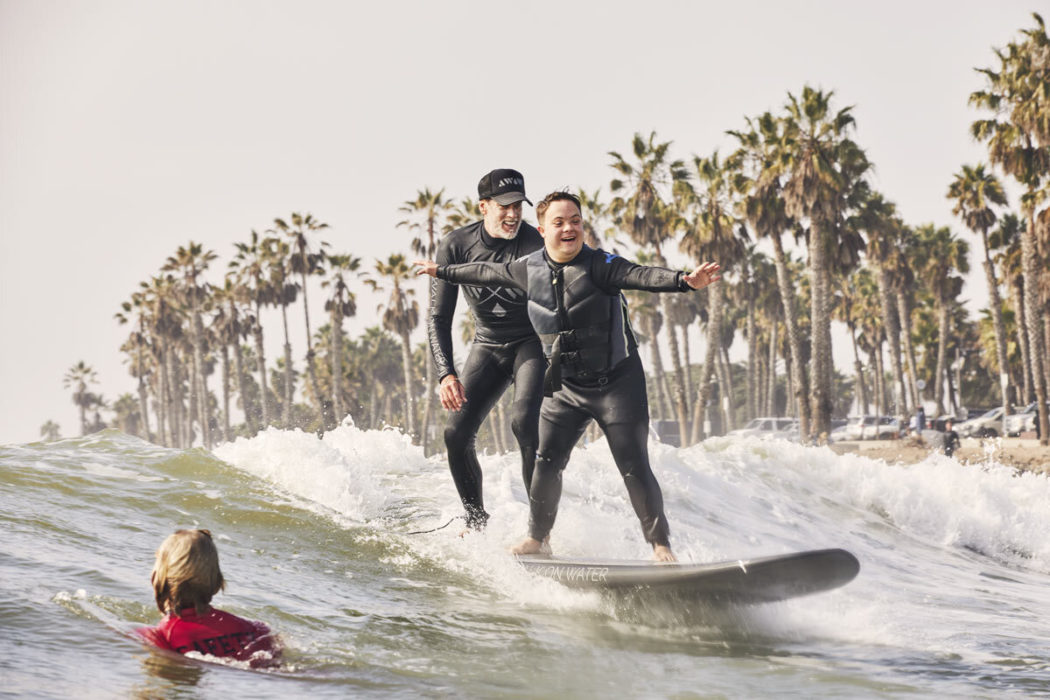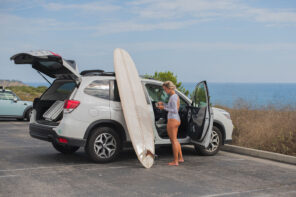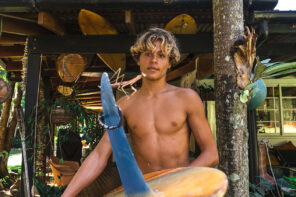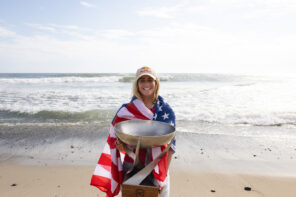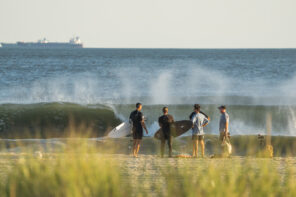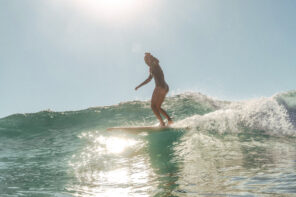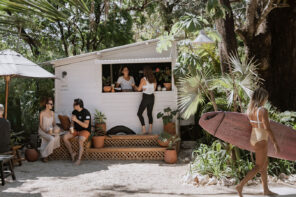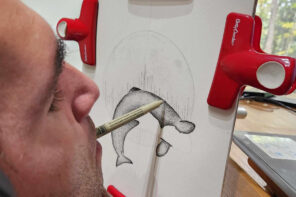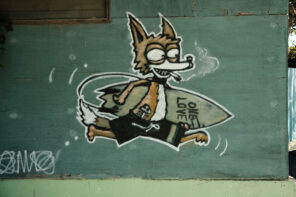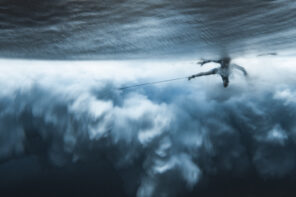An Interview with A Walk on Water’s Steven Lippman
Photos courtesy of AWOW
Boxed Water™ is changing our relationship with how we consume water. Store shelves are a sea of plastic, so they took a new approach. And they want to give a platform to humans taking a novel approach to the world’s problems. The following story is one of those humans.
Bob Marley once sang, “In high seas or in low seas/ I’m gonna be your friend/ I’m gonna be your friend/ In high seas or in low seas/ I’ll be by your side/ I’ll be by your side.” No other organization gives life to these lyrics better than A Walk on Water, which provides ocean and surf therapy to unique children with special needs and their families. In celebrating its 10th anniversary, we caught up with its co-founder and director, Steve Lippman, to learn about his personal experience in the water and what makes AWOW stand out amongst other organizations.

Whalebone: What makes A Walk On Water so special to the children and the families you work with?
Steve Lippman: We are about ocean therapy. Introducing families and children with special needs through surf therapy based around the ocean, creating a bond, creating trust, engaging with them, to give them an experience that they’ll hold forever.
Some children are more skeptical at first—not really adaptable immediately. It really takes a lot of persistence and teamwork to get some of these athletes in the water. Once they get in the water, it’s a whole transformation. Now, when I say athletes, it’s our children with special needs. We call them athletes.
The families of the children are the true heroes. To be able to do this on a day-to-day basis, then to get them to these events—our goal is to create an experience, not just for the athlete, but for the families.
WB: How does the process work for encouraging the children to enter the water and jump on a board?
SL: There have been times where our surf therapists have been out there for over an hour or more just sitting with the athlete on the board, engaging with the water, picking up seaweed, showing them birds and little fish, and getting acclimated to the water. Once we sort of establish that experience and trust, then we move over into the break and really engage with them amongst their peers in the water, celebrate, and share waves. Then, there’s a completely different endorphin rush that happens: The water’s rushing up over your feet, sometimes splashing on your face and in your hands, you feel this great energy between both of you and you just really experience something that is unforgettable.
WB: How does the event production work?
SL: A Walk On Water is based around volunteers. We have incredible volunteers that are also people that donate. They donate their time, they donate money and that’s what makes it possible. Without our volunteers, I don’t think we have enough substance. We really appreciate and respect our volunteers.
We have volunteers that just check in, that are there supporting, and so forth. We have our junior ambassadors—that come out to engage and start to learn about the organization and what it’s like to give back and help others less fortunate than yourself. Then we have our red jerseys, those who are primarily water men and water women that are CPR certified lifeguards, to assist the surf instructor in case someone falls or there’s an issue—they’re ready within three seconds. We have our chaperones, which wear yellow jerseys, that help with the wetsuits, putting on the wetsuits and pairing the athletes with a surf instructor. Then we have our surf instructors, which wear the black jerseys—men and women that are incredible surfers and really special individuals—learning how to adapt to a child that’s non-verbal, high on the spectrum, or those that are a bit erratic. And then we also have our blue jerseys that help facilitate the athletes to and from the water.
The families of the children are the true heroes. To be able to do this on a day-to-day basis, then to get them to these events—our goal is to create an experience, not just for the athlete, but for the families. We want the families to relax and let us take over now, with their permission, of course. We’re creating these experiences for thousands of families around the nation.
WB: Is there a particular aspect of the organization that you find to be especially rewarding?
SL: There’s a lot of experiences where there are children that we have been working with for the last five to ten years—we’ve created relationships with these families—and there’s no better feeling than when you get there and all of a sudden, one of the athletes that you’ve been working with for years sees you and is running down the beach with their arms open. You feel like this is on the same level of enjoyment that you have with your own children. You’re creating something so unique and special that you want more of it.
You want to be able to give more and you want to be able to change their lives in a positive way, empowering them to feel that they’re special, that they can do it. To get them out in the water, get them on a board, and just to experience that, that itself is a huge achievement.
WB: You’ve hosted events in Whalebone’s home base of Montauk before. Do you enjoy hosting in MTK?
SL: Montauk is one of my favorite events. I’ve never seen a community come together like Montauk with open arms and invite us into their homes, their restaurants, their cafes, their hotels, and ice cream parlors. I’m so humbled by the charm and class that Montauk puts on. I’m thankful to be able to have Montauk as one of our stops and to make us feel like family, it’s a really special thing for us.

WB: Can you share a bit more about the importance of nature/environment and how that impacts the well-being of us as humans?
SL: Many of our AWOW volunteers, myself included, take part in beach clean-ups in their local communities, and we always try to leave the beach cleaner than we found it after our events. That said, we humans, who get so much out of the ocean, must do a better job of taking care of her. It breaks my heart to read stories about how our negative human impact has created giant plastic flotillas, is killing our marine life, and warming the waters in other untenable ways. I urge everyone who has ever experienced the healing power of the waves, or even just gazed out at the water and found peace, to recommit every day to being better stewards. The ocean needs us right now as much as we need her
WB: What was the moment when the water changed you?
SL: That’s a big question and it has different moments for me. Number one—I was a pro skateboarder in the ’70s and was introduced to surfing when I was 15. I was landlocked in backyard swimming pools and skate parks. I was just a skate rat, a full-on skate rat. Introduced to surfing in Malibu, I was hooked. As soon as I discovered surfing, I wanted nothing more than to surf every moment, every waking second of my life. That’s when the water changed me.
WB: What is the change you are looking to make in the water?
SL: I was always keen to give back, but then when [A Walk On Water] first happened, I realized, wow, this is something really, really special. I didn’t even know that you could feel this way. All I want to do is hug this person, love this person, and give back to this person. I just want to see this person smile. I want to see them grow. I want to see them change. I want to build their confidence.
The love changed when I was introduced to surf therapy and Pat Notaro, who’s our founder. He assembled a team, me, and four other guys and we started from scratch. We wanted to create A Walk On Water so that it had its own legs, its own idea so that we could control it. We wanted to do it our way and make it special—not just work with children with autism, but work with children and adults of all sorts: Wounded warriors, paraplegics, children and adults with obstacles in their life. The end result was still all the same: We were giving back.
The other change that we’re looking to do is create surf therapy experiences in artificial waves around the world. To be able to create an infrastructure where we’re able to make that a part of a day-to-day routine for these [wave pools] where insurance pays for it.
If your child needs to learn how to walk or needs to learn how to speak, or just working with their body functions or what have you, they can choose the therapist of their choice. Why can’t families have the choice to choose surf therapy, built on insurance? If you’re landlocked and you live in Texas, and your child has special needs, you’re like, “I can’t go to Malibu. I can’t go to Montauk. I have to get on a plane to go do that.” These wave pools are opening up all over the nation, all over the world, in places that are landlocked that can now give families with special needs access to [surf therapy].
I just want to see this person smile. I want to see them grow. I want to see them change. I want to build their confidence.
WB: What is one thing anyone can do to help or get involved?
SL: Well, you can go to www.awalkonwater.org, go to volunteer, or the department you want to be involved in. If you qualify for that part, such as water safety or surf instructor, you just sign up for that and if you get in, then you can come to the event and be a part of it. If you don’t get in, don’t be discouraged, still come down and be a part of it as a spectator and see what’s going on. Introduce yourself. And if I’m at the event, I’ll always find something for you to do, or someone will find something for you to do. That’s one way to get involved.
The other way you can get involved is that you can donate to A Walk On Water. If you are a business, you can offer your facilities and say, “Hey, I’d like to sponsor your event. I am in…” wherever you want to be. Or, you can be a host at an event through a personal donation or from a business, and that starts at $10,000 for a host. You get your name on your shirt, you’re on the flyer —you kind of claim it as your own.
There are multiple ways to get involved. If someone has a question about it, they’re more than welcome to also call and ask, “How can I be involved? This is what I have to offer.”

